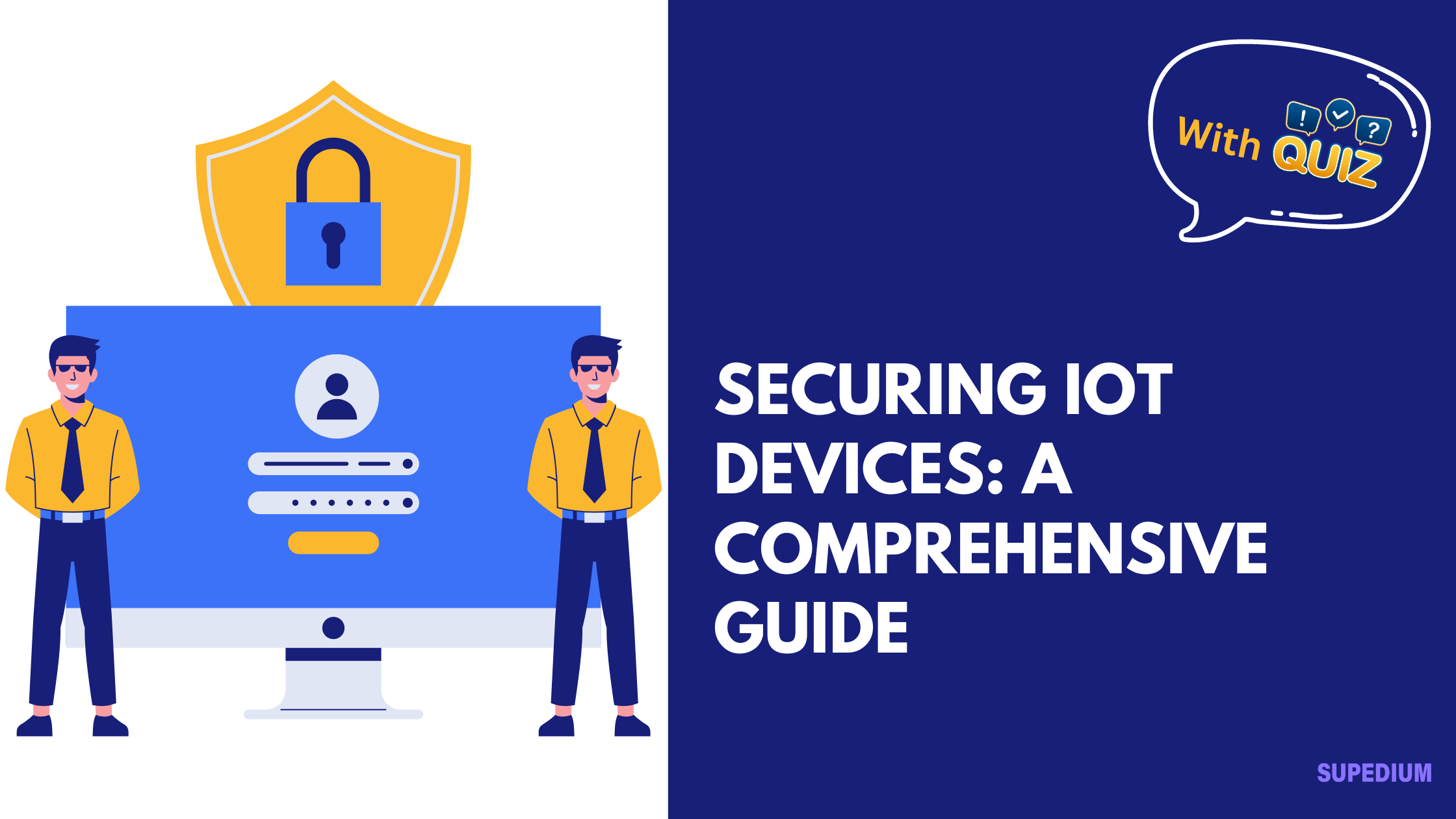Table of Contents
![]()
Introduction
The Internet of Things (IoT) refers to the network of interconnected devices that communicate and exchange data over the internet. From smart thermostats and security cameras to wearable fitness trackers and smart appliances, IoT devices have become integral to modern life. They offer convenience, efficiency, and enhanced capabilities. However, the proliferation of IoT devices also brings significant security challenges. With their increasing presence in homes, businesses, and critical infrastructure, securing these devices has become crucial to safeguarding privacy and ensuring safety.
Understanding IoT Device Vulnerabilities
Common Vulnerabilities in IoT Devices
- Weak or Hard-Coded Passwords: Many IoT devices come with default passwords that are often easy to guess or commonly known. These hard-coded passwords can be exploited by attackers if not changed immediately.
- Inadequate Encryption: Some IoT devices do not use encryption to protect data transmitted over the network. This lack of encryption makes it easier for attackers to intercept and access sensitive information.
- Lack of Software Updates and Patches: IoT devices often lack mechanisms for automatic updates or patches. When vulnerabilities are discovered, manufacturers may not release timely updates, leaving devices exposed to exploitation.
- Insecure Network Communications: Devices that do not use secure communication protocols can be vulnerable to various attacks, such as eavesdropping or man-in-the-middle attacks.
Threat Models
- Physical Attacks: Attackers with physical access to IoT devices can manipulate or tamper with them to gain unauthorized access or control.
- Network-Based Attacks: These include man-in-the-middle attacks where an attacker intercepts and potentially alters communications between devices, or denial-of-service attacks that overwhelm devices with excessive traffic.
- Remote Exploitation: IoT devices can be targeted remotely through vulnerabilities in their software or network interfaces, leading to potential compromises like forming part of a botnet or conducting distributed denial-of-service (DDoS) attacks.
Best Practices for Securing IoT Devices
Device Configuration
- Change Default Passwords: Always change default passwords and use strong, unique credentials. Avoid using easily guessable passwords and consider implementing multi-factor authentication where possible.
- Disable Unnecessary Services and Ports: Disable any services or ports that are not needed for the device’s functionality. This reduces the potential attack surface.
Network Security
- Segment IoT Devices: Place IoT devices on a separate network from critical systems. Network segmentation limits the impact of a compromised device and prevents unauthorized access to sensitive data.
- Use Firewalls and Network Monitoring Tools: Implement firewalls to block unauthorized access and use network monitoring tools to detect unusual activity or potential threats.
- Implement Secure Communication Protocols: Ensure that devices use secure protocols such as HTTPS or TLS to encrypt data in transit, protecting it from interception and tampering.
Data Security
- Encrypt Sensitive Data: Encrypt data both at rest and in transit. This makes it harder for attackers to access or understand the data if intercepted.
- Regular Updates and Patches: Regularly update device firmware and software to address vulnerabilities and apply security patches provided by manufacturers.
Access Control
- Implement Role-Based Access Control (RBAC): Use RBAC to manage who can access and control devices. Limit access based on roles and responsibilities to minimize potential misuse.
- Use Multi-Factor Authentication (MFA): Where possible, implement MFA to provide an additional layer of security beyond just passwords.
Regular Audits and Monitoring
- Conduct Security Assessments: Regularly perform security assessments and vulnerability scans to identify and address potential weaknesses in IoT devices.
- Monitor Device Logs and Network Traffic: Keep an eye on device logs and network traffic for signs of suspicious activity. Early detection of anomalies can prevent more serious breaches.
Regulatory and Industry Standards
Overview of IoT Security Regulations
- General Data Protection Regulation (GDPR): GDPR imposes strict data protection requirements on entities handling personal data, including those using IoT devices. Compliance involves ensuring data privacy and security in device operations.
- California Consumer Privacy Act (CCPA): CCPA grants California residents rights regarding their personal data, including data collected by IoT devices. Businesses must ensure that they handle and protect data according to these regulations.
- IoT Cybersecurity Improvement Act (USA): This act focuses on enhancing the security of IoT devices used by federal agencies, establishing guidelines for secure device design and procurement.
Industry Standards and Frameworks
- NIST IoT Framework: The National Institute of Standards and Technology (NIST) provides a framework for managing IoT security risks, including guidelines for securing IoT devices and systems.
- IETF Standards: The Internet Engineering Task Force (IETF) develops standards for secure communication protocols used by IoT devices, such as those related to encryption and data integrity.
- ISO Standards: The International Organization for Standardization (ISO) offers various standards related to information security management, including those applicable to IoT environments.
Case Studies and Real-World Examples
Notable IoT Security Breaches
- Mirai Botnet Attack: The Mirai Botnet attack in 2016 exploited vulnerable IoT devices with default credentials to create a massive botnet. This botnet was used to launch a widespread DDoS attack, disrupting internet services globally.
- Ring Doorbell Vulnerabilities: Several vulnerabilities in Ring doorbell cameras exposed users to privacy risks, including unauthorized access to video feeds and potential manipulation of device functions.
Lessons Learned from Security Incidents
- Timely Updates and Patches: The importance of timely updates is evident. Regularly applying updates and patches is crucial to addressing known vulnerabilities and protecting devices from exploitation.
- Comprehensive Security Strategies: Effective IoT security requires a holistic approach, integrating device configuration, network security, data protection, and continuous monitoring.
Future Trends and Challenges
Emerging Technologies and Their Impact on IoT Security
- Artificial Intelligence and Machine Learning: AI and machine learning can enhance IoT security by improving threat detection and response capabilities. However, they also introduce new risks, such as adversarial attacks targeting AI algorithms.
- Edge Computing: Edge computing involves processing data closer to where it is generated, which can improve performance and reduce latency. However, it also requires robust security measures to protect decentralized processing environments.
Challenges in Securing Next-Generation IoT Devices
- Increasing Complexity: As IoT devices become more complex and interconnected, managing their security becomes more challenging. Ensuring that all components are secure and updated is a growing concern.
- Balancing Security with Performance: Ensuring robust security while maintaining device performance and usability requires careful consideration. Overly stringent security measures may impact device functionality or user experience.
Conclusion
Securing IoT devices is essential to protecting privacy, ensuring safety, and maintaining trust in connected technologies. By understanding the vulnerabilities, implementing best practices, adhering to regulatory standards, and staying informed about emerging threats, individuals and organizations can better safeguard their IoT ecosystems. As the IoT landscape continues to evolve, ongoing vigilance and adaptation will be key to addressing new security challenges and maintaining robust defenses against potential threats.






Be the first to comment